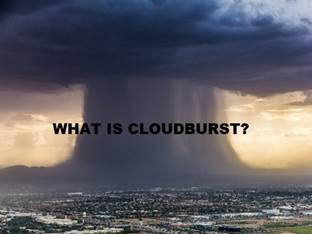Cloudburst

Disclaimer: Copyright infringement not intended.
Context
- Over 20 people have been killed in destruction caused by cloudbursts and flash floods in different parts of Himachal Pradesh and Uttarakhand over the last three days.
What is a cloudburst?
- Cloudbursts are short-duration, intense rainfall events over a small area.
- According to the India Meteorological Department (IMD), it is a weather phenomenon with unexpected precipitation exceeding 100mm/h over a geographical region of approximately 20-30 square km.
- Not all instances of very heavy rainfall, are cloudbursts. A cloudburst has a very specific definition: Rainfall of 10 cm or more in an hour over a roughly 10 km x 10-km area is classified as a cloudburst event. By this definition, 5 cm of rainfall in a half- hour period over the same area would also be categorized as a cloudburst.
Occurrence
- Cloudburst is basically a rainstorm and occurs mostly in the desert and mountainous regions, and in interior regions of continental landmasses due to the warm air current from the ground or below the clouds rushes up and carries the falling raindrops up with it.
- The rain fails to fall down in a steady shower, which causes excessive condensation in the clouds as new drops form and old drops are pushed back into it by the updraft.
Meteorological Factors behind the Cloudburst
- Atmospheric pressure, atmospheric temperature, rainfall, cloud water content, cloud fraction, cloud particle radius, cloud mixing ratio, total cloud cover, wind speed, wind direction, and relative humidity during the cloudburst, before as well as after the cloudburst.
- Relative humidity and cloud cover is at the maximum level with low temperature and slow winds.
Can cloudbursts be forecast?
- The India Meteorological Department forecasts rainfall events well in advance, but it does not predict the quantum of rainfall — in fact, no meteorological agency does. The forecasts can be about light, heavy, or very heavy rainfall, but weather scientists do not have the capability to predict exactly how much rain is likely to fall at any given place.
- Additionally, the forecasts are for a relatively large geographical area, usually a region, a state, a meteorological sub-division, or at best a district. As they zoom in over smaller areas, the forecasts get more and more uncertain. Theoretically, it is not impossible to forecast rainfall over a very small area as well, but it requires a very dense network of weather instruments, and computing capabilities that seem unfeasible with current technologies.
- As a result, specific cloudburst events cannot be forecast.
Studies
- Several studies have shown that climate change will increase the frequency and intensity of cloudbursts in many cities across the globe.
- World Meteorological Organization notedthat there is about a 40% chance of the annual average global temperature temporarily reaching 1.5°C above the pre-industrial level in at least one of the next five years.
- It added that there is a 90% likelihood of at least one year between 2021 and 2025 becoming the warmest on record and dislodge 2016 from the top rank.
- As temperatures increase the atmosphere can hold more and more moisture and this moisture comes down as a short very intense rainfall for a short duration probably half an hour or one hour resulting in flash floods in the mountainous areas and urban floods in the cities.
- Also, there is evidence suggesting that globally short duration rainfall extremes are going to become more intense and frequent.
- With warming climate or climate change, we will witness these cloudburst events in increased frequency in the future.




1.png)
